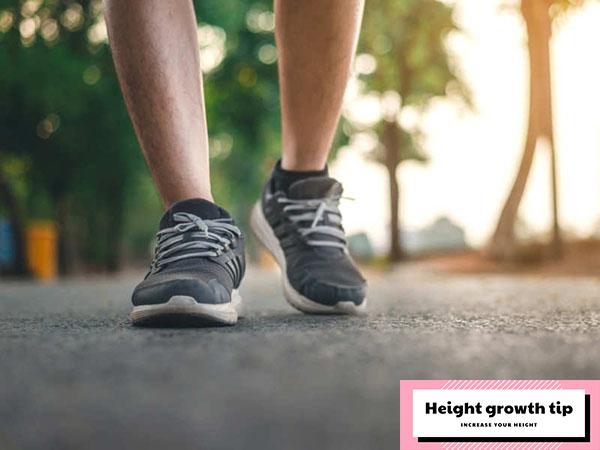Exploring the Indirect Influence of Walking on Height
Walking, often considered a fundamental form of physical activity, possesses the potential to exert an indirect influence on an individual’s height by significantly contributing to their overall health and well-being. While it is undeniable that walking alone may not serve as a direct catalyst for height increase, its far-reaching impact extends to numerous factors that intricately intertwine with the complex process of height growth. In this extensive discourse, we shall embark on a profound exploration of the multifaceted ways in which the act of walking can affect an individual’s stature, unveiling the intricate mechanisms that underlie this intriguing relationship.
-
Impact on Bone Health:
Walking serves as a weight-bearing exercise, subjecting our skeletal framework to a beneficial stressor. This physiological stress response triggers a cascade of events wherein bones fortify themselves, gradually becoming denser and more resilient. This heightened bone density, a critical component of our structural foundation, indirectly contributes to the maintenance and potential augmentation of one’s height. Over time, a consistent walking regimen fosters the development of robust bones, thereby enhancing height prospects.
-
Promotion of Upright Posture:
The act of walking, when executed with impeccable posture, can yield a profound influence on an individual’s overall height. Walking with an upright posture aligns the spine correctly, allowing the body to attain its full vertical potential. By discouraging slouching and promoting an elegant and confident bearing, proper posture during walking plays a pivotal role in the quest for increased stature.
-
Spinal Decompression:
Particularly when coupled with impeccable form and technique, walking emerges as a remedy for spinal compression. Prolonged periods of sedentary behavior or the maintenance of poor posture can culminate in the compression of spinal discs, resulting in a temporary reduction in height. Engaging in a regimen of regular walking and physical activity serves as a countermeasure to this compression, potentially facilitating the restoration of lost height.
-
Holistic Well-being:
Walking, widely recognized as a holistic form of exercise, exerts a far-reaching influence on overall well-being. It not only augments cardiovascular fitness but also strengthens muscles and enhances flexibility. By nurturing a state of good physical health, walking sets the stage for optimal growth and development, indirectly shaping one’s height potential.
Nevertheless, it is imperative to acknowledge that genetic factors remain the predominant determinants of an individual’s ultimate height. Height potential is profoundly shaped by the genetic legacy inherited from one’s parents and close relatives. However, the interplay of lifestyle elements, including regular walking, supplementary exercises such as stretching and resistance training, the maintenance of a well-balanced diet rich in essential nutrients, and the cultivation of proper posture, all coalesce to unlock an individual’s maximum height potential.
It is crucial to recognize that while walking indeed constitutes a valuable component of a height-maximizing strategy, it may not suffice as the sole agent for substantial height increase. To further amplify height growth, prudent individuals are advised to complement their walking routine with additional exercises and stretches. Furthermore, maintaining a balanced diet that is replete with essential nutrients, vitamins, and minerals stands as a pivotal cornerstone for comprehensive growth and height attainment.

Mastering the Art of Walking for Enhanced Posture and Height Potential
Walking alone may not be a magic formula to increase your height, but by incorporating specific techniques and maintaining proper posture, you can unlock your height potential. In this comprehensive guide, we will explore the art of walking in a way that not only promotes better posture but also enhances your perception of height.
- Prioritize Perfect Posture: Achieving impeccable posture is the key to maximizing your height. While walking, keep your head held high, pull your shoulders back, and maintain a straight spine. Avoid slouching or leaning forward. Imagine an invisible thread pulling you upward from the crown of your head, elongating your spine and promoting an upright stance.
- Activate Your Core Muscles: Engaging your core muscles while walking is crucial for supporting proper posture. Draw your belly button towards your spine, activating your abdominal muscles. This action stabilizes your core and helps you maintain an upright posture.
- Sync Your Arm Swing: Coordinate the movement of your arms with your stride. Bend your elbows at approximately 90 degrees and swing your arms rhythmically in opposition to your leg movements. This enhances balance, rhythm, and overall walking efficiency.
- Opt for Longer Strides: Focus on taking longer strides rather than quick, short steps. Slightly lengthening your stride can help stretch and strengthen your leg and lower body muscles. However, avoid overstriding excessively, as it can lead to unnatural walking patterns and discomfort.
- Walk with Purpose: Walk confidently and purposefully. Maintain a moderate pace that feels comfortable to you. Avoid extremes of walking too fast or too slowly, as both can disrupt your natural gait and posture.
- Embrace Inclined Terrain: Incorporating uphill walking into your routine offers additional benefits for your lower body muscles and posture. It engages your calves, quadriceps, and glutes, promoting strength and flexibility in your lower body. Uphill walking also encourages you to maintain proper posture and use your leg muscles effectively.
- Cultivate Consistent Walking Habits: Dedication is key. Aim to include walking in your daily routine, dedicating 30 minutes to an hour each day to this activity. Consistent walking helps maintain the advantages of improved posture, muscle strength, and overall well-being.
It’s important to understand that while walking can contribute to overall wellness and height potential, it’s just one piece of the puzzle. Genetic factors, nutrition, and complementary exercises also play significant roles. To maximize your height potential, commit to a health-conscious lifestyle that addresses multiple aspects of height development.
In conclusion, by embracing proper posture, engaging core muscles, extending your strides, and incorporating consistent walking into your daily life, you can align your body for optimal posture and potentially unlock your full height potential.
Elevating Your Height: Holistic Strategies for Maximum Growth Potential
In the pursuit of height enhancement, it’s essential to explore additional dimensions beyond what has already been discussed. While perfecting your posture and incorporating daily walking are vital components, there are more facets to consider that can significantly contribute to maximizing your height potential without redundancy. Here, we delve into these critical factors:
Nutritional Mastery:
A well-rounded diet is a cornerstone of effective height growth. Focus on consuming foods rich in crucial nutrients like calcium, vitamin D, and phosphorus, all of which play pivotal roles in promoting strong bone development. Your dietary regimen should include dairy products, leafy greens, nuts, seeds, and fortified foods. Don’t forget the importance of staying hydrated and getting sufficient sleep for optimal results.
Pre-Walk Preparation:
To safeguard against injuries and prepare your body for physical activity, it’s imperative to start your walking routine with a proper warm-up. Engage in exercises that enhance blood circulation and reduce the risk of muscle strain. Begin by balancing on one foot and rotating your ankles, followed by gentle leg swings. This primes your muscles and improves overall circulation.
Gradual Speed Adjustment:
When commencing your walk, start with a leisurely pace for approximately 5 minutes. Gradually increase your speed to a moderate level, eventually transitioning to your desired walking pace. This gradual acceleration allows your body to adapt and warm up progressively. As you near the end of your walk, gently decrease your pace over about 5 minutes to facilitate a gradual cooling-down phase.
Avoid Sudden Stops:
To minimize the risk of injury and ensure a smooth transition from activity to rest, steer clear of abrupt halts at the end of your walk. Sudden stops can strain muscles and disrupt the natural flow of your exercise routine. Instead, gradually reduce your pace, giving your body time to adjust and cool down gradually.
Commitment and Patience:
Height enhancement is a gradual process that demands unwavering consistency and patience. Make walking a daily ritual firmly embedded in your routine, as persistence over time yields superior results. It’s crucial to understand that significant height transformation doesn’t happen overnight, underscoring the importance of commitment and patience on your journey.
Diversify Physical Activities:
For enhanced bone development and comprehensive growth benefits, consider incorporating other sports or exercises alongside your walking routine. Activities like swimming, running, or basketball engage various muscle groups and contribute to overall fitness.

The Expansive Health Benefits of Walking: Going Beyond the Quest for Height
Walking, a deceptively simple yet incredibly powerful exercise, opens the door to a wealth of health benefits that extend far beyond its speculated impact on height. Integrating regular walks into your daily routine can lead to a holistic improvement in overall well-being and positively affect various dimensions of your health. Here, we explore a diverse range of health advantages associated with the act of walking:
1. Cardiovascular Health:
- Walking serves as an effective cardiovascular workout, fortifying the heart and promoting better circulation.
- It contributes to the reduction of blood pressure, mitigates the risk of heart disease, and elevates overall cardiovascular fitness.
2. Weight Management:
- Walking plays a pivotal role in weight management and the prevention of obesity.
- It burns calories, accelerates metabolism, and facilitates healthy fat loss when combined with a balanced diet.
3. Mental Well-being:
- The positive impact of walking on mental health cannot be overstated, as it helps alleviate stress, anxiety, and symptoms of depression.
- Outdoor walks, especially in natural environments, offer a serene and rejuvenating experience with profound mental health benefits.
4. Joint Health and Flexibility:
- Being a low-impact activity, walking places minimal strain on joints compared to high-impact exercises.
- It enhances joint mobility, reduces the risk of arthritis, and strengthens the muscles that support the joints.
5. Bone Health:
- Weight-bearing exercises like walking are instrumental in maintaining strong bones, thwarting bone loss, and reducing the likelihood of osteoporosis.
- Outdoor walks provide exposure to sunlight, facilitating the synthesis of natural vitamin D, a cornerstone of bone health.
6. Improved Digestion:
- Walking promotes healthy digestion by stimulating abdominal muscles.
- It assists in maintaining regular bowel movements, preventing constipation, and supporting a well-functioning digestive system.
7. Enhanced Immunity:
- Regular physical activity, including walking, bolsters the immune system by boosting the production of antibodies and white blood cells—crucial components in the body’s defense against infections and illnesses.
8. Increased Energy Levels:
- Walking enhances oxygen circulation, leading to a natural energy boost.
- This dynamic activity combats fatigue, improves focus, concentration, and overall productivity.
9. Enhanced Sleep Quality:
- Engaging in physical activities like walking has a positive impact on sleep quality.
- It helps regulate the sleep-wake cycle, promoting deeper, more restorative sleep and a refreshed awakening.
10. Longevity and Disease Prevention:
- Consistent walking is linked to a reduced risk of chronic diseases such as diabetes, stroke, and certain types of cancer.
- It correlates with a healthier lifestyle and an extended life expectancy.
Incorporating walking into your daily routine isn’t just about height enhancement; it’s about embracing a comprehensive approach to health and well-being. Enjoy the physical engagement, set achievable goals, and make walking a steadfast part of your lifestyle to unlock a multitude of health benefits that will enrich your life
Frequently Asked Questions
Can walking alone increase height?
Walking alone may not significantly increase height. However, it can improve posture and create an illusion of increased height.
How much should I walk to increase height?
The duration and intensity of walking required to increase height vary for each individual. It is advisable to consult a healthcare professional or fitness trainer for personalized guidance.
Are there any specific walking techniques for height growth?
While there are no specific walking techniques for height growth, maintaining good posture during walks can contribute to a taller appearance.
Can I increase my height after puberty?
The growth plates in bones close after puberty, limiting the potential for height increase. However, exercises and lifestyle choices can still optimize height potential.
What other lifestyle factors contribute to height increase?
Factors such as sufficient sleep, proper posture, stress management, and avoiding smoking and excessive alcohol consumption can positively influence height growth.

